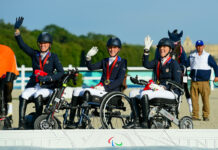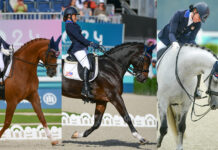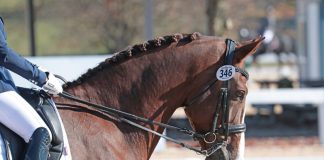Like most riders, you might resent the thought of one more day in the arena. Even when armed with homework from your last lesson, arena riding can become uninspired and boring. When this happens, it’s difficult to find clear goals for your workouts. Plus, if you are bored, imagine how your horse feels.

If you have fallen into a rut, it probably means your horse is using his body repetitively. In addition to predisposing him to injury, this makes his movement dull over time. Variety in your routine is critical for keeping your horse’s neurosensory system in good working order, recruiting muscle fibers at different intensities, and maintaining looseness.
With all this in mind, here are a few go-to exercises for infusing your normal routine with a good dose of boredom-busting. As a bonus, you will be creating a better equine athlete.
Basic Box
 First, set out four 8-foot ground poles to create a box (with the ends touching) in the center of your arena. If possible, leave this box set up for a week; you will use it in your warm-up each day. Your task is to ride through or around the box in a different way every day. I have given you some suggestions below, but feel free to invent your own challenges.
First, set out four 8-foot ground poles to create a box (with the ends touching) in the center of your arena. If possible, leave this box set up for a week; you will use it in your warm-up each day. Your task is to ride through or around the box in a different way every day. I have given you some suggestions below, but feel free to invent your own challenges.
Day 1:
In a working trot, ride through the box to change direction in every possible way you can imagine. For instance, begin on the right rein and trot straight through the middle of the box, then turn left to change direction. Now, loop around and ride through the box sideways and turn right. Then ride through the box diagonally from corner to corner. Find all kinds of ways to loop, circle or cut sideways through the box while maintaining your trot and changing direction.
Variation:
Alternate riding over the poles in sitting trot and rising trot.
Day 2:
Trot into the center of the box and halt. Now ride a turn on the forehand without knocking any poles, and then exit the box, either walking or trotting.
Day 3:
Choose one side of the box and ask your horse to straddle the pole. Keeping the pole under his belly, ask him to sidepass along the edges of the square.
Day 4:
Ride through the box as in day 1, except now make a transition between gaits in the middle of the box. For instance, ride straight at the box and then as soon as your horse crosses the first pole, transition up to canter or down to walk, or from walk to trot, et cetera.

Half ‘n’ Half
 For this exercise, it helps to mark the center of your ground poles with some paint, a piece of tape, or an X of some kind. This target will prevent you from drifting to the outer edge of each pole.
For this exercise, it helps to mark the center of your ground poles with some paint, a piece of tape, or an X of some kind. This target will prevent you from drifting to the outer edge of each pole.
- Mark out a 20-meter circle. Imagining that the circle is a clock face, lay a ground pole at 3 o’clock and 9 o’clock so that the track of the circle crosses through the center of each ground pole.
- Begin in a working trot and ride around your circle. Be sure to cross the center of each pole, not the edges.
- Count your strides between poles. Each front leg landing counts as a stride. Most horses will take approximately 22 to 26 strides per half circle.
- Next, ride twice around the circle, maintaining the same number of strides between poles.
- Ride one half of your circle—from 3 o’clock to 9 o’clock—in a more ground-covering trot. Count your strides. If you accurately change your horse’s length of stride, you should cover this distance in approximately 20 strides. Challenge yourself to see if you can hit the mark with even fewer strides.
- For the second half of your circle, from 9 o’clock to 3 o’clock, ask your horse to resume his normal stride count, based on the stride number you counted in the beginning. This will mean you need to cue him to downshift and clearly slow down.
- Continue riding around the circle this way, maintaining your geometry and counting strides (and changing the number of them) on
each half of the circle.
Now do the same routine in the canter!
Canter Paperclip
 This exercise serves as a good shake-up from the usual routine of circles and straight lines, which can lead to a listless canter devoid of any loft or collection. It is what I call a “double-whammy exercise” because it improves the horse’s performance as well as the rider’s aids and effectiveness. Quite simply, if you are out of balance or weak with your aids, the pattern will not work. Also, if your horse’s canter is suffering from lack of impulsion, roundness or uphill balance, this exercise will be a challenge. But it will lead to a more balanced canter, one where your horse is squarely under your seat instead of rushing out the front or bulging to one side.
This exercise serves as a good shake-up from the usual routine of circles and straight lines, which can lead to a listless canter devoid of any loft or collection. It is what I call a “double-whammy exercise” because it improves the horse’s performance as well as the rider’s aids and effectiveness. Quite simply, if you are out of balance or weak with your aids, the pattern will not work. Also, if your horse’s canter is suffering from lack of impulsion, roundness or uphill balance, this exercise will be a challenge. But it will lead to a more balanced canter, one where your horse is squarely under your seat instead of rushing out the front or bulging to one side.
For this exercise, you need to make sure you have the proper position while cantering: Keep your outside leg behind your inside leg. It should remain slightly farther back in order to guide your horse’s outside hind leg—which is the propulsive leg and driving force—straight under his body to act as a guardrail, preventing the haunches from swinging outward.
- Begin in a working canter tracking right. At A, ride a 15-meter circle to establish your rhythm.
- Ride a horse’s length past K and turn across the arena diagonally. You will be aiming for the corner between C and M. Aim to arrive at the rail just past C.
- Turn right to ride through the corner between C and M. Maintain exactly the same rhythm.
- At M, turn back across the diagonal to return to K. Aim for the corner between A and K.
- Your figure should look like a paperclip. Don’t change your lead on this exercise; it is not a direction change. You are simply cantering from corner to corner and making a tight bend while maintaining your lead at each corner.
Exercises like these that require stride adjustment, regardless of gait, improve a horse’s athleticism and balance. These types of routines recruit muscle fibers at different rates of force and speed, causing them to develop propulsive power and more fine-tuned limb control.
Practicing these exercises also delivers unexpected feedback about your effectiveness as a rider. For instance, you might think you are using your seat clearly but then find yourself plowing through the pattern without achieving the correct stride counts. Or maybe you hold your breath and tighten your hands, which will cause your horse to raise his neck and hollow his back. Exercises like these give you tangible, real-time opportunities to recognize your habits and give you a chance to fix them.
This article originally appeared in the March 2013 issue of Horse Illustrated. Click here to subscribe.







Great exercises.